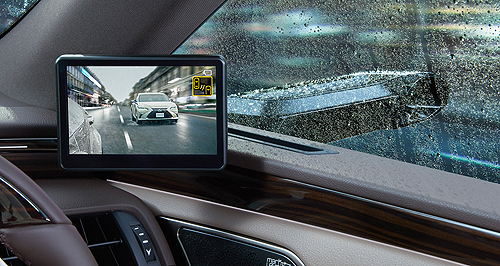Make / Model Search
News - LexusLexus rearview cameras to debut on ESJapan-only rearview cameras to debut on new Lexus ES in production world first13 Sep 2018 LEXUS has joined a growing number of car-makers proposing rearview cameras in place of exterior mirrors, putting pressure on road safety legislators to modify existing rules that ban such devices.
In a production-car world first, the Japanese luxury car-maker has announced it will install cameras instead of wing mirrors on its all-new ES large sedan in Japan when it goes on sale there in the last quarter of this year.
The company has no plans to introduce the technology outside of Japan “at this time”, particularly in Australia where Australian Design Rules (ADRs) require mandatory mirrors of specific design parameters.
Lexus could apply for an exemption to the rule, which reflects United Nations standards for global markets, but there is no indication that it will try.
Germany’s Audi recently announced similar technology on its all-electric e-tron large SUV that will be unveiled in the flesh in San Francisco next week.
Again, Audi might have to stick with conventional mirrors when the e-tron lands in Australia in the second half of next year unless the rule is changed firstly at the UN level and then in Australia by federal authorities by the time the vehicle goes through the local ADR homologation process.
Motor industry sources say it is possible that such a change could go before the UN Economic Commission for Europe (UNECE) Working Party 29 which considers changes to design rules to accommodate new technologies.
These changes then go before the World Forum for Harmonisation of Vehicle Regulations for ratification.
Australia draws down these changes for ADRs that apply to all mass-sale vehicles sold in Australia.
Car-makers have long fitted futuristic rearview cameras to concept cars, arguing the aerodynamic and fuel economy benefits of the tiny devices compared with large mirrors.
Road safety administrators have resisted the switch, arguing that response times of images and other drawbacks such as performance in low-light conditions have not been up to scratch compared with old-fashioned mirrors.
In the case of Lexus, the cameras on arms extending from the doors transmit the images to 5.0-inch screens inside the cabin at the base of each of the A-pillars.
The company argues that the cameras – shaped to resist accumulation of raindrops or snow – provide a clearer rear view on the screens.
It also claims that the smaller camera mounts give a better forward view through the side windows while also cutting wind noise.
“The system automatically enhances the corresponding area – left, right or behind – when the turn signals are activated, or when the transmission is put into reverse,” it says. “The view of areas around the car can be manually enhanced by the driver to obtain complete peripheral awareness of the area around the vehicle.”
Audi’s e-tron system works similarly, but with bigger 7.0-inch screens on the A-pillars and manual adjustment that allows the driver to select from three different views, including highway driving, turning and parking, while also moving or zooming in and out of the live feed for greater detail.
Because the e-tron is not set to go into production until next year, Lexus gets the bragging rights by being first to market with the ES that will go on sale in Japan next month before being rolled out next year in Australia where it will be sold only in hybrid form.
To date, one of the few car-makers to introduce a form of rearview camera is Honda which has models with a blind-spot monitor. The cars comply with ADRs because they have conventional exterior mirrors, but when the driver flicks the indicator to move left, a camera on the left-hand mirror transmits an image of the road to the central touchscreen to alert the driver if the coast is clear or a vehicle is tucked in the blind spot.
The advent of reversing cameras on most modern cars has helped to accelerate the camera and screen technology in automotive applications.
Ultimately, such rearview technologies will be largely redundant when autonomous vehicles fitted with radar sensors come to the fore. Cars such as Mercedes-Benz’s E-Class can already change lanes automatically on freeways, guided by sensor technologies.  Read more |
Click to shareLexus articlesMotor industry news |












Facebook Twitter Instagram